Microscope
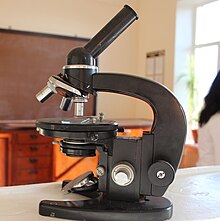 | |
| Uses | Small sample observation |
|---|---|
| Notable experiments | Discovery of cells |
| Related items | Optical microscope Electron microscope |
A microscope (from
There are many types of microscopes, and they may be grouped in different ways. One way is to describe the method an instrument uses to interact with a sample and produce images, either by sending a beam of
History
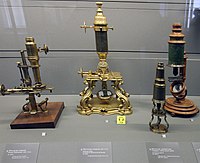
Although objects resembling lenses date back 4,000 years and there are
Rise of modern light microscopes

The first detailed account of the microscopic anatomy of organic tissue based on the use of a microscope did not appear until 1644, in Giambattista Odierna's L'occhio della mosca, or The Fly's Eye.[16]
The microscope was still largely a novelty until the 1660s and 1670s when naturalists in Italy, the Netherlands and England began using them to study biology. Italian scientist Marcello Malpighi, called the father of histology by some historians of biology, began his analysis of biological structures with the lungs. The publication in 1665 of Robert Hooke's Micrographia had a huge impact, largely because of its impressive illustrations. Hooke created tiny lenses of small glass globules made by fusing the ends of threads of spun glass.[15] A significant contribution came from Antonie van Leeuwenhoek who achieved up to 300 times magnification using a simple single lens microscope. He sandwiched a very small glass ball lens between the holes in two metal plates riveted together, and with an adjustable-by-screws needle attached to mount the specimen.[17] Then, Van Leeuwenhoek re-discovered red blood cells (after Jan Swammerdam) and spermatozoa, and helped popularise the use of microscopes to view biological ultrastructure. On 9 October 1676, van Leeuwenhoek reported the discovery of micro-organisms.[16]
The performance of a compound light microscope depends on the quality and correct use of the condensor lens system to focus light on the specimen and the objective lens to capture the light from the specimen and form an image.[5] Early instruments were limited until this principle was fully appreciated and developed from the late 19th to very early 20th century, and until electric lamps were available as light sources. In 1893 August Köhler developed a key principle of sample illumination, Köhler illumination, which is central to achieving the theoretical limits of resolution for the light microscope. This method of sample illumination produces even lighting and overcomes the limited contrast and resolution imposed by early techniques of sample illumination. Further developments in sample illumination came from the discovery of phase contrast by Frits Zernike in 1953, and differential interference contrast illumination by Georges Nomarski in 1955; both of which allow imaging of unstained, transparent samples.
Electron microscopes

In the early 20th century a significant alternative to the light microscope was developed, an instrument that uses a beam of
Development of the transmission electron microscope was quickly followed in 1935 by the development of the scanning electron microscope by Max Knoll.[18] Although TEMs were being used for research before WWII, and became popular afterwards, the SEM was not commercially available until 1965.
Transmission electron microscopes became popular following the
One of the latest discoveries made about using an electron microscope is the ability to identify a virus.[19] Since this microscope produces a visible, clear image of small organelles, in an electron microscope there is no need for reagents to see the virus or harmful cells, resulting in a more efficient way to detect pathogens.
Scanning probe microscopes

From 1981 to 1983
New types of scanning probe microscope have continued to be developed as the ability to machine ultra-fine probes and tips has advanced.
Fluorescence microscopes
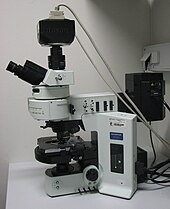
The most recent developments in light microscope largely centre on the rise of fluorescence microscopy in biology.[21] During the last decades of the 20th century, particularly in the post-genomic era, many techniques for fluorescent staining of cellular structures were developed.[21] The main groups of techniques involve targeted chemical staining of particular cell structures, for example, the chemical compound DAPI to label DNA, use of antibodies conjugated to fluorescent reporters, see immunofluorescence, and fluorescent proteins, such as green fluorescent protein.[22] These techniques use these different fluorophores for analysis of cell structure at a molecular level in both live and fixed samples.
The rise of fluorescence microscopy drove the development of a major modern microscope design, the
Super resolution microscopes
Much current research (in the early 21st century) on optical microscope techniques is focused on development of
X-ray microscopes
X-ray microscopes are instruments that use electromagnetic radiation usually in the soft X-ray band to image objects. Technological advances in X-ray lens optics in the early 1970s made the instrument a viable imaging choice.[25] They are often used in tomography (see micro-computed tomography) to produce three dimensional images of objects, including biological materials that have not been chemically fixed. Currently research is being done to improve optics for hard X-rays which have greater penetrating power.[25]
Types
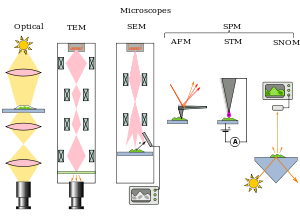

Microscopes can be separated into several different classes. One grouping is based on what interacts with the sample to generate the image, i.e.,
Wide field optical microscopes and transmission electron microscopes both use the theory of lenses (
Scanning optical and electron microscopes, like the confocal microscope and scanning electron microscope, use lenses to focus a spot of light or electrons onto the sample then analyze the signals generated by the beam interacting with the sample. The point is then scanned over the sample to analyze a rectangular region. Magnification of the image is achieved by displaying the data from scanning a physically small sample area on a relatively large screen. These microscopes have the same resolution limit as wide field optical, probe, and electron microscopes.
Scanning probe microscopes also analyze a single point in the sample and then scan the probe over a rectangular sample region to build up an image. As these microscopes do not use electromagnetic or electron radiation for imaging they are not subject to the same resolution limit as the optical and electron microscopes described above.
Optical microscope
The most common type of microscope (and the first invented) is the
Sarfus is a recent optical technique that increases the sensitivity of a standard optical microscope to a point where it is possible to directly visualize nanometric films (down to 0.3 nanometre) and isolated nano-objects (down to 2 nm-diameter). The technique is based on the use of non-reflecting substrates for cross-polarized reflected light microscopy.
In

The traditional optical microscope has more recently evolved into the digital microscope. In addition to, or instead of, directly viewing the object through the eyepieces, a type of sensor similar to those used in a digital camera is used to obtain an image, which is then displayed on a computer monitor. These sensors may use CMOS or charge-coupled device (CCD) technology, depending on the application.
Digital microscopy with very low light levels to avoid damage to vulnerable biological samples is available using sensitive
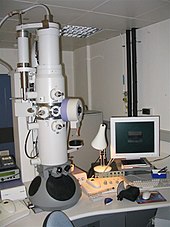
Electron microscope
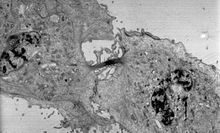
The two major types of electron microscopes are
Scanning probe
The different types of scanning probe microscopes arise from the many different types of interactions that occur when a small probe is scanned over and interacts with a specimen. These interactions or modes can be recorded or mapped as function of location on the surface to form a characterization map. The three most common types of scanning probe microscopes are
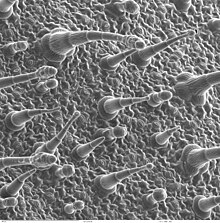
Other types
Scanning acoustic microscopes use sound waves to measure variations in acoustic impedance. Similar to Sonar in principle, they are used for such jobs as detecting defects in the subsurfaces of materials including those found in integrated circuits. On February 4, 2013, Australian engineers built a "quantum microscope" which provides unparalleled precision.[30]
Mobile apps
Mobile app microscopes can optionally be used as optical microscope when the flashlight is activated. However, mobile app microscopes are harder to use due to visual noise, are often limited to 40x, and the resolution limits of the camera lens itself.
See also
References
- ISBN 978-0-470-23300-9.
- S2CID 96668398.
- ^ Atti Della Fondazione Giorgio Ronchi E Contributi Dell'Istituto Nazionale Di Ottica, Volume 30, La Fondazione-1975, p. 554
- ^ ISBN 978-0-471-69214-0.
- ^ Sir Norman Lockyer (1876). Nature Volume 14.
- ISBN 978-90-6984-615-6.
- ^ "Who Invented the Microscope?". Live Science. 14 September 2013. Retrieved 31 March 2017.
- ISBN 978-90-04-18671-2.
- ^ William Rosenthal, Spectacles and Other Vision Aids: A History and Guide to Collecting, Norman Publishing, 1996, pp. 391–92
- ^ Raymond J. Seeger, Men of Physics: Galileo Galilei, His Life and His Works, Elsevier – 2016, p. 24
- ^ J. William Rosenthal, Spectacles and Other Vision Aids: A History and Guide to Collecting, Norman Publishing, 1996, page 391
- ^ uoregon.edu, Galileo Galilei (Excerpt from the Encyclopedia Britannica)
- ISBN 978-0-224-05044-9.
- ^ a b Henker, Otto (1911). . In Chisholm, Hugh (ed.). Encyclopædia Britannica. Vol. 18 (11th ed.). Cambridge University Press. p. 392.
- ^ ISBN 978-0-19-280355-9.[page needed]
- ^ Liz Logan (27 April 2016). "Early Microscopes Revealed a New World of Tiny Living Things". Smithsonian.com. Retrieved 3 June 2016.
- ^ Knoll, Max (1935). "Aufladepotentiel und Sekundäremission elektronenbestrahlter Körper". Zeitschrift für Technische Physik. 16: 467–475.
- PMID 19822888.
- ISBN 978-3-540-34315-8.
- ^ a b c d e f g h i j Lodish, Harvey; Berk, Arnold; Zipursky, S. Lawrence; Matsudaira, Paul; Baltimore, David; Darnell, James (2000). "Microscopy and Cell Architecture". Molecular Cell Biology. 4th Edition.
- ^ a b c d e f g Alberts, Bruce; Johnson, Alexander; Lewis, Julian; Raff, Martin; Roberts, Keith; Walter, Peter (2002). "Looking at the Structure of Cells in the Microscope". Molecular Biology of the Cell. 4th Edition.
- ^ "The Nobel Prize in Chemistry 2014 – Scientific Background" (PDF). www.nobelprize.org. Retrieved 2018-03-20.
- ^ "The Nobel Prize in Chemistry 2014". www.nobelprize.org. Retrieved 2018-03-20.
- ^ ISBN 978-3-540-74561-7.
- S2CID 41889433.
- ISSN 2334-2536.
- ^ ISBN 978-3-642-02525-9.
- ISBN 978-3-642-56949-4.
- ^ "Quantum Microscope for Living Biology". Science Daily. 4 February 2013. Retrieved 5 February 2013.


